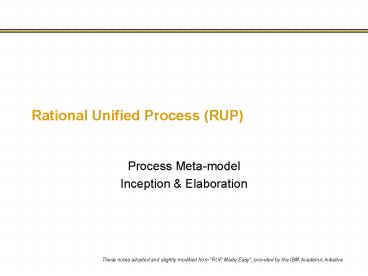Rational Unified Process (RUP) PowerPoint PPT Presentation
1 / 13
Title: Rational Unified Process (RUP)
1
Rational Unified Process (RUP)
- Process Meta-model
- Inception Elaboration
These notes adopted and slightly modified from
RUP Made Easy, provided by the IBM Academic
Initiative
2
Agenda
- Iterative Development with RUP
- Inception Phase Objectives
- Elaboration Phase Objectives
- Project and Iteration Planning
3
Rational Unified Process (RUP)
4
Iterative Development and RUP
- Inception Understand what to build
- Vision, high-level requirements, business case
- Not detailed requirements
- Elaboration Understand how to build it
- Baseline architecture, most requirements detailed
- Not detailed design
- Construction Build the product
- Working product, system test complete
- Transition Validate solution
- Stakeholder acceptance
An iteration is a distinct sequence of activities
with an established plan and evaluation criteria,
resulting in an executable release.
5
Inception Know What to Build
- Prepare vision document and initial business case
- Include risk assessment and resource estimate
- Develop high-level project requirements
- Initial scenarios and domain models (10-20
complete) - Manage project scope
- Reduce risk by identifying all key requirements
- Acknowledge that requirements will change
- Manage change, use iterative process
Inception
Elaboration
Construction
Transition
6
Objectives with Inception
- 1. Understand what to build
- Vision who wants the system, its value, and
its scope - Project Vision document with needs, features,
and scope - 2. Identify key requirements
- Critical use cases and non-functional
requirements - Project You will create a Use Case catalog with
priorities - 3. Determine at least one potential solution
- Identify candidate architecture
- Project Your team will identify a prototype to
start on - 4. Understand costs, schedule and risk
- Business case, Software Development Plan, and
Risk List - Project Will create versions of these (Status
reports, SW Dev Plan) - 5. Understand what process to follow and tools to
use - RUP configuration, development case, and
customized tools - Project Discuss with faculty mentor and industry
sponsor
7
Elaboration Know How to Build It
- Detail reqs as necessary (80 complete)
- Less essential reqs may not be fully fleshed out
- Produce an executable stable architecture
- Define/code/test major component interfaces
- Identify dependencies on external components
- Key components will be partially implemented
- Roughly 10-20 of code is implemented.
- Drive architecture with key use cases
- 20 of use cases drive 80 of the architecture
- Design, code test key scenarios for use cases
- Verify architectural qualities
- Reliability (Stress), Scalability Perf (Load)
test - Continuously assess business case, risk profile
and development plan
Inception
Elaboration
Construction
Transition
8
Objectives with Elaboration
- 1. Get a more detailed understanding of
requirements - Move from 20 to 80 of requirements captured
- Project Yes you will do this
- 2. Design, implement, validate and baseline the
architecture - Make critical design decisions buy vs. build,
patterns, .. - Baseline a skeleton structure of your system
- Perform initial load and performance test
- Project You will do the 1st bullet, maybe some
of the 2nd - 3. Mitigate risks, produce more accurate schedule
cost estimates - You know what to build, and have less risk
accurate schedule - Project You will write a Software Development
Plan for the Spring, and assess risk continuously
- 4. Fine-tune and deploy development environment
- Harvest experiences from Inception
- Rollout development environment
- Project Understanding deployment is an issue
often overlooked!
9
Obj. 1 Get a Detailed Understanding of Reqs
- By end of elaboration
- Detail 80 of use cases
- Produce storyboards of visually oriented use
cases (at least mock-up) - Walk through use cases with stakeholders
- For use case with partial implementationsdemo
- Detail non-functional requirements (all that have
an impact on arch!) - Time box! You will never be done, you can fix
issues in later iterations - What is not done
- Use cases with no or very limited associated risk
(If you have done one print use case, do you
need to do more?) - Use cases that are expected to be volatile, and
have little impact on end solution or stakeholder
satisfaction
10
Objective 2 Design, Implement, Validate and
Baseline the Architecture
- The most important building blocks of the
systems - Build, buy, or reuse?
- Interaction between these building blocks to
provide key scenarios - Required to verify the architecture
- Run-time architecture
- Processes, threads, nodes,
- Architectural patterns
- Dealing with persistence, inter-process
communication, recovery, authentication, garbage
collection, - Test framework allowing testing of key
capabilities - Performance, scalability, reliability, load,
protocols, and other key non-functional
requirements
11
Obj. 3 Mitigate Essential Risks, Produce More
Accurate Schedule Cost Estimates
- Most key risks addressed
- Technical risks by implementing and testing the
architecture - Business risks by implementing and testing key
functionality - Team- and tool-oriented risks by having the team
going through the full software lifecycle
implementing real code, using the tools at hand - Schedule cost estimates can be radically
improved as we - Have mitigated key risks
- Understand a vast majority of the requirements
- Understand which building blocks needs to be
implemented and tested - Understand which building blocks can be acquired,
and to what cost - Understand how effective our team is
12
Objective 4 Fine-tune Deploy Dev Env
- Fine-tune your development case based on the
experiences so far - Do customizations and improvements of the tool
environment as required - Make it easy for all team members to find and use
reusable assets, including the architectural
patterns you developed in Elaboration - Do training of your team and deploy tools
13
Elaboration Summary
- How do the objectives map to your project?
- Elaboration
- Complete the SRS - write review (33)
- Complete a prototype review (33)
- Produce a SW Development Plan for the Spring,
including architecture recommendations (16) - Fine-tune the environment (16)

